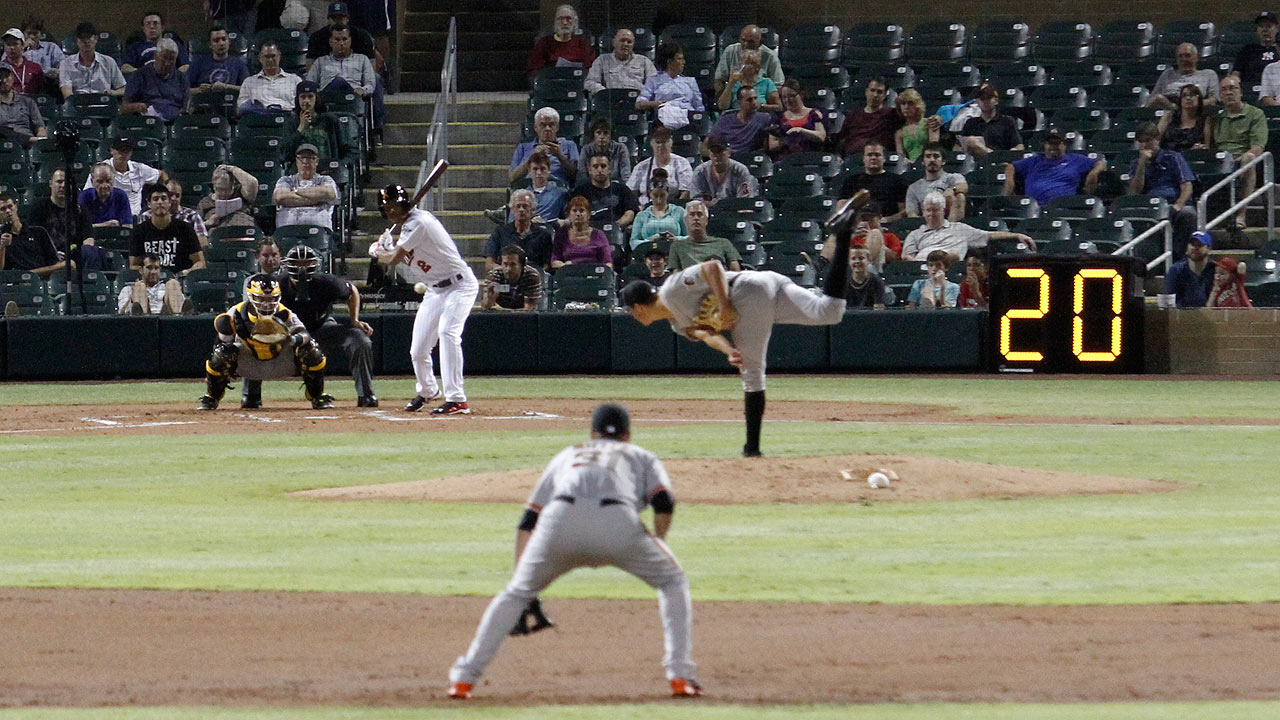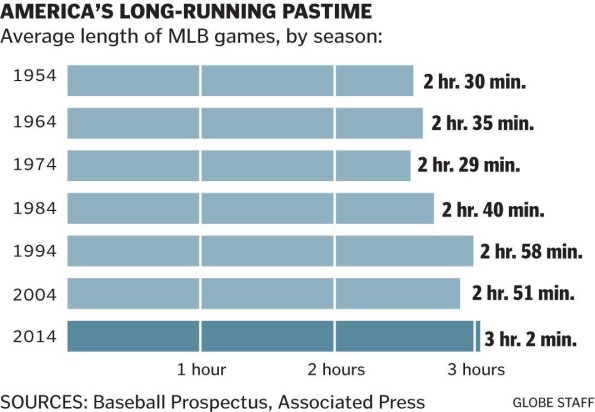By: Blake Cole, Published August 4, 2015
Baseball has never been a quick sport. Pitchers have developed in-depth wind-up and delivery routines They are more apt to attempt the pick-off at first. Batters consistently walk away after each pitch to check their gloves, helmets, and other equipment. Pitching coaches and catchers like to have conferences at the mound. Umpires converse almost every time a manager disagrees with a call. Bullpen pitchers get their warm-ups on the hill. There are many dynamics to a Major League Baseball game that contribute to the length of each outing. It seems that over the course of the past five years, fans have become annoyed, almost inconvenienced, by the amount of time it takes to complete a game. Younger fans find the sport dull and boring, and often divert the majority of their attention to higher action sports like the NFL or NBA. The older fan base is accustomed to the baseball traditions, and many don’t have a problem with the current pace of play. No matter what your particular opinion may be, the MLB has decided that steps need to be put into place to speed up the game. During the 2014 MLB season, an average ball game lasted 3 hours, 2 minutes, and 25 seconds, despite seeing decreased offensive production. Baseball officials also used the 2014 season to test new pace of play practices in the minor league system. Let’s take a brief look at some of the changes that were experimented with in the 2014 Arizona Fall League: (courtesy of mlb.com)
- Batter Box Rule - Batters must keep at least one foot in the batter’s box during the entire at-bat. Exceptions include foul balls, wild pitches, pitches forcing the batter out, and “time” being requested, and few others.
- No-Pitch Intentional Walks - If a team decides to intentionally walk a batter, pitches are no longer thrown. A team’s manager can signal from the dugout with four fingers, and the batter will be allowed to proceed to first base.
- 2:30 Inning Break - There will be a maximum of 2:30 break between innings. Hitters have to be in the box by the 2:15 mark. If the batter is not present by the alotted mark, the umpire will call an automatic strike. If the batter is present, but the pitcher fails to deliver the pitch by the 2:30 mark, the Umpire will call a ball.
- 2:30 Pitching Change Clock - There will be a maximum of 2:30 between pitching changes, including changes that occur during an inning break. The first pitch must be delivered by the 2:30 mark, or the Umpire shall call a ball.The clock begins when the new pitcher enters the field (crosses the warning track, foul line, etc.)
- Three “Time Out” Limit - Each team only gets three “time out” conferences per game, including extra innings. These shall include player conferences with the pitcher (including catcher), manager and/or coach conferences with the catcher or batter. Conferences during pitching changes, “time outs” called for injury or other emergencies are excluded.
- 20-Second Rule - The pitcher must deliver a pitch within 20 seconds of receiving the ball. If the pitch is delivered after the 20 second mark, the Umpire shall call a ball. If the batter is outside the box when the pitch is delivered, the Umpire shall call a strike.
These six steps touch on every opportunity to delay a game that was mentioned above. The changes lowered the average Arizona Fall League game by 11 minutes. Apparently, the MLB like what they saw and implemented some changes to our current 2015 season. In February, Major League officials announced the changes in pace of play. They noted that they weren’t to be as strict as those set in the minors, but still aimed to shorten the overall length of the game.
- Hitters must keep one foot in the batter’s box during the entire at-bat.
- The start time of an inning after a commercial break was shortened.
- Coaches can call for a replay from the dugout.
These new rules don’t seem too terribly complicated, but they actually are. The MLB is asking players to change what they have been focusing on for their entire lives. These players have been coached into a routine by their coaches, managers, and trainers. This has occurred their whole lives. This has occurred since the very start of baseball. The league understands this, and expresses their intent to be patient with both players and coaches, as they learn to follow the new guidelines. Commissioner Manfred has gone on record stating that he, and his team, will open all options and explore all possibilities to improve the game. He knows that his younger fan base is disappearing, and new sports enthusiasts are drifting to other avenues. NFL games last an average of 3 hours and 12 minutes, but it’s hardly noticed with the big hits and long drives. Long-time baseball fans will tell you that the same thrill NFL fans get from a big hit, or breakaway touchdown run, can be had when enduring the tension of a bases loaded situation, or an inside-the-park home run. Is the NFL attempting to speed up their pace of play?
What truly matters is what you make of the situation. For me, it’s family and friends getting together to cheer on our team. It’s the feeling of opening day excitement. It’s seeing your favorite player step up to the plate, and crossing your fingers that he slams one out of the park and right into your glove. It’s watching the rivalries. It’s crowding the water cooler at work the next day, to discuss the highlights. It’s fireworks with your significant other after the game. It’s taking your little one to their first game. It’s sharing something you love, with someone you love. It’s bonding over a passion you’ve had for many, many years. Whether the games are two hours long, or four hours long, it’s what you make of that time that matters most.

